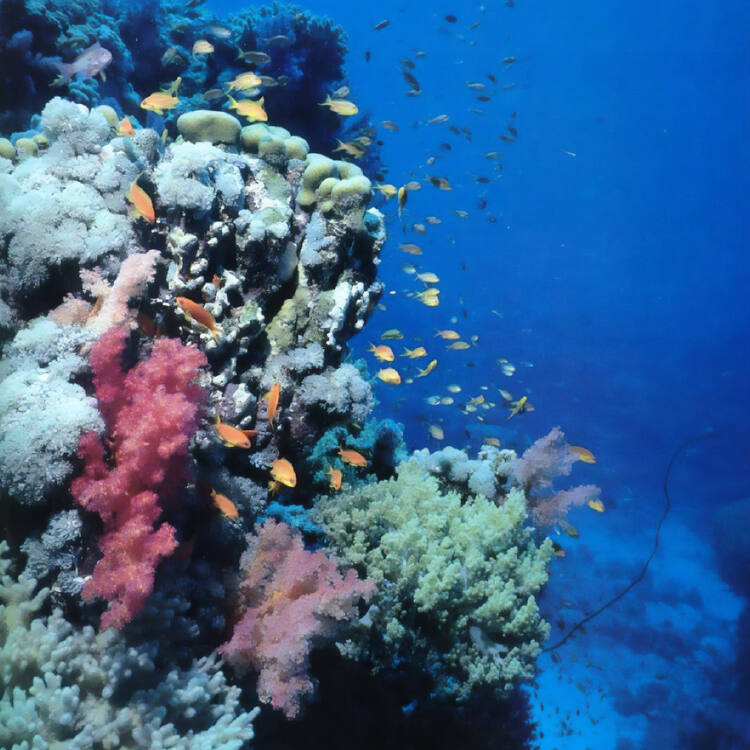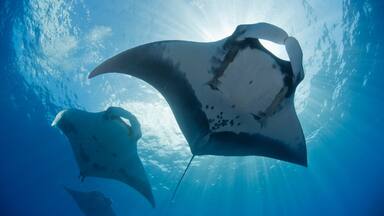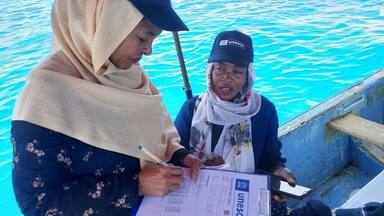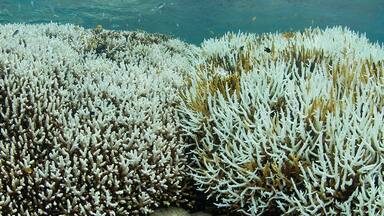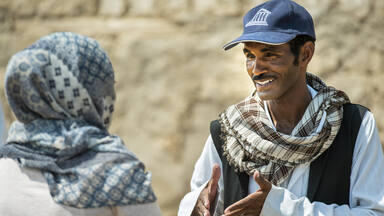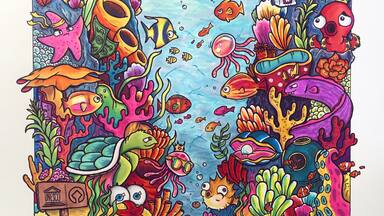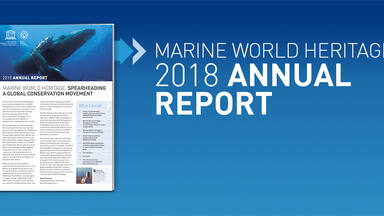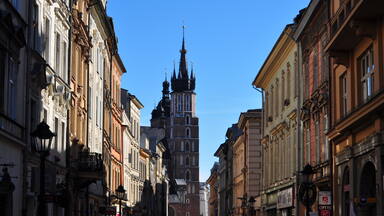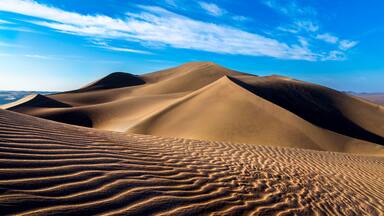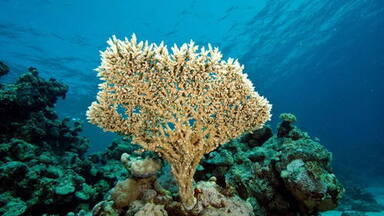Sanganeb Marine National Park and Dungonab Bay – Mukkawar Island Marine National Park
Sanganeb Marine National Park and Dungonab Bay – Mukkawar Island Marine National Park
The property consists of two separate areas: Sanganeb is an isolated, coral reef structure in the central Red Sea and the only atoll, 25 km off the shoreline of Sudan. The second component of the property is made up of Dungonab Bay and Mukkawar Island, situated 125 km north of Port Sudan. It includes a highly diverse system of coral reefs, mangroves, seagrass beds, beaches and islets. The site provides a habitat for populations of seabirds, marine mammals, fish, sharks, turtles and manta rays. Dungonab Bay also has a globally significant population of dugongs.
Description is available under license CC-BY-SA IGO 3.0
Parc national marin de Sanganeb et Parc national marin de la baie de Dungonab – île de Mukkawar
Le bien se compose de deux zones séparées : Sanganeb est une structure récifale corallienne isolée, située au centre de la mer Rouge dont elle est l’unique atoll, à 25 km au large du littoral du Soudan. Le deuxième élément du bien est constitué de la baie de Dungonab et de l’île de Mukkawar. Ces dernières sont situées à 125 km au nord de Port-Soudan, et comprennent un système très varié de récifs coralliens, de mangroves, d'herbiers marins, de plages et d'îlots. Le bien sert d’habitat à des populations d’oiseaux de mer, de mammifères marins, de poissons, de requins, de tortues et de raies manta. La baie de Dungonab abrite également une population d’importance mondiale de dugongs.
Description is available under license CC-BY-SA IGO 3.0
المحمية البحرية القومية لسنجانب والحديقة البحرية القومية لخليج جزيرة دنقناب في جزيرة مكوار
source: UNESCO/CPE
Description is available under license CC-BY-SA IGO 3.0
Sanganeb国家海洋公园和Dungonab海湾—Mukkawar岛国家海洋公园
这片遗产地由两个独立单元构成,Sanganeb位于苏丹海岸以外25公里,是红海中部一座孤立的珊瑚礁和唯一的环状珊瑚岛;另外一部分是位于苏丹港北部125公里的Dungonab海湾和Mukkawar岛,这里有非常多样的珊瑚礁、红树林、海草床、沙滩和小岛构成的生态系统,为海鸟、海洋哺乳动物、鱼类、鲨鱼、海龟及巨蝠鲼提供了栖息地。全世界很大一部分儒艮都在Dungonab海湾栖息。
source: UNESCO/CPE
Description is available under license CC-BY-SA IGO 3.0
Национальные морские заповедники «Санганеб» и «Бухта Дунгонаб – остров Мековар»
source: UNESCO/CPE
Description is available under license CC-BY-SA IGO 3.0
Parque Nacional Marino de Sanganeb y Parque Nacional Marino de la Bahía de Dungonab y la Isla de Mukkawar
source: UNESCO/CPE
Description is available under license CC-BY-SA IGO 3.0
サンガニブ海洋国立公園とドングナブ湾-ムカクル島海洋国立公園
source: NFUAJ
Sanganeb Nationaal Marinepark en de Baai van Dungonab – Mukkawar Eiland Nationaal Marinepark
Source: unesco.nl
Outstanding Universal Value
Brief synthesis
The Sanganeb Marine National Park and the Dungonab Bay – Mukkawar Island Marine National Park are located in the northern part of the Red Sea. The property is a serial site and covers 260,700 ha with a buffer zone of 504,600 ha consisting of both marine and terrestrial areas. The property’s marine systems, fauna and flora are from an Indian Ocean origin, however, due to its semi-enclosed nature, it has developed unique and different ecosystems and species.
The property contains impressive natural phenomena, reef formations and areas of great natural beauty and is relatively undisturbed. The two components of the property are connected by a coastal stretch extending 125 km including mersas, inlets, fringing reefs and off-shore reef formations, and the whole serial site is geologically and ecologically connected via the open flows that facilitate the exchange of biotic and abiotic elements within the marine ecosystems of the Red Sea. It encompasses a large bay that contains islands, several small islets and some of the most northerly coral reefs in the world associated with species (including seagrass and mangroves) at the limits of their global range and evolutionary expansion, which are therefore important from a scientific and conservation perspective.
Sanganeb atoll is the only atoll-like feature in the Red Sea, and a submerged and overhanging predator dominated coral reef ecosystem. It consists of 13 different bio-physiographic reef zones, each providing typical coral reef assemblages, supporting a wealth of marine life and breathtaking underwater vistas, hosting over 300 fish species with numerous endemic and rare species. Besides providing important nurseries and spawning grounds for key species, it also hosts resident populations of dolphins, sharks and marine turtles, which use the atoll as a resting, breeding and feeding area.
Dungonab Bay, including Mukkawar Island and other islands, contains an array of habitat types, such as extensive coral reef complexes, mangroves, seagrasses and intertidal and mudflat areas which all enable the survival (breeding, feeding and resting) of endangered dugong, sharks, manta rays, dolphins and migratory birds.
Criterion (vii): Sanganeb is an isolated, atoll-shaped coral reef structure in the central Red Sea, 25 km off the shoreline of Sudan. Surrounded by 800 m deep water, the atoll-like coral reef systems are part of the northernmost coral reef systems in the world. Sanganeb is a largely pristine marine ecosystem providing some of the most impressive underwater vistas resulting from the very high diversity of physiographic zones and reefs characterized by an extraordinary structural complexity. Dungonab Bay and Mukkawar Island is situated 125 km north of Port Sudan and includes within its boundaries a highly diverse system of coral reefs, mangroves, seagrass beds, beaches, intertidal areas, islands and islets. The clear visibility of the water, coral diversity, marine species, pristine habitats and colourful coral reef communities create a striking land- and seascape.
Criterion (ix): The property is located in an ecologically and globally outstanding region, the Red Sea, which is the world’s northernmost tropical sea, the warmest and most saline of the world´s seas, and is a Global 200 priority biogeographic region. The property is part of a larger transition area between northern and southern Red Sea biogeographic zones and contains diverse and mostly undisturbed habitats which are outstanding examples of the northernmost tropical coral reef system on earth. The property and its surrounding area include reef systems (13 different bio-physiographic reef zones in Sanganeb Marine National Park (SMNP)), the only atoll-like feature in the Red Sea, lagoons, islets, sand flats, seagrass beds, and mangrove habitats and display a diversity of reefs, from living reefs to ancient fossil reefs. These habitats are home to populations of seabirds (20 species), marine mammals (11 species), fish (300 species), corals (260 species), sharks, manta rays and marine turtles, and the site provides important feeding grounds for what is perhaps the most northerly population of endangered Dugong. SMNP is an important larvae source area and hosts spawning sites for commercial fish species.
Criterion (x): Dungonab Bay – Mukkawar Marine National Park (DMNP) supports a globally significant dugong population, given that the Red Sea and the Persian Gulf host the last remaining healthy populations of this species in the Indian Ocean. The whale and manta ray seasonal aggregations in DMNP are unique to the entire Western Indian Ocean Region and the marine park is internationally recognized as an Important Bird Area for both resident and migratory birds. DMNP is also unique as a home to species from different biogeographic origins: both northern and southern Red Sea species. SMNP lies in a regional hotspot for reef fish endemism. The property supports a high level of representation of endemic species found in the Red Sea, including the richest diversity of coral west of India and a number of coral species which are at the limits of their global range.
Integrity
The property is an outstanding marine ecosystem that sustains intact ecological functions. It covers both shallow habitats and reef formations and deep-sea areas that are ecologically interacting by natural exchange.
The property’s size is adequate to contain most of the attributes that convey Outstanding Universal Value and maintains a high level of intactness through long-term conservation of its biodiversity. Sanganeb atoll is relatively remote from land-based activities and the traditional artisanal fishing around it is under the control of the Fisheries Administration of Sudan. Dungonab Bay’s marine waters are protected by Wildlife Administration and Fisheries regulations. If these regulations are not promptly enforced, Dungonab Bay is likely to suffer negative impacts on the biota from the activities of the two villages at the coast, from major land use changes, salt exploitation, oyster farming, and potentially pearling. Species which are likely to be affected are coral and fish species, turtles, manta rays, sharks, dolphins, dugongs, and birds. The property has not shown any invasive or non-resident species as yet.
Protection and management requirements
The Government of Sudan has a legal commitment at both the National and State levels towards the protection and conservation of resources within its coastal waters through its comprehensive National Strategy. Several laws and regulations are in place and Sudan has signed regional and international protocols and conventions. Both SMNP (1990) and DMNP (2004) have been declared as marine protected areas by Presidential Decrees. Both are the responsibility of the Government of Sudan and various pieces of national legislation pertain to the property including the Federal Environmental Law (2001); State Environmental Law (2006); Wildlife Conservation and National Park Act (1987); National Parks, Sanctuaries and Reserves Regulation (1939); and the Game Protection and Federal Parks Act (1986).
At the time of inscription, work to update the management plans for the two National Parks was underway and this needs to be urgently completed and such plans maintained in the long-term so that both protected areas have up-to-date comprehensive plans. There is, in addition, a need to develop and maintain in the long-term an integrated management framework to coordinate management for the serial site as a whole and thus complement the two individual management plans. The participation of local communities and other stakeholders is critical to the effective management of this large property. The management authority acknowledges the importance of monitoring the impacts of tourism on ecosystems and on local communities through the implementation of a Tourism Strategy.
The property ecosystems remain relatively weakly affected by human activities. However, regional coastal development increased recently and reinforces the need to protect these landward and marine areas. The increase of activities from local residents and tourists could intensify pollution and direct damage on ecosystems such as anchor, boat and diving damage. In addition, coral communities could be affected by predators and by coral bleaching in response to climate change. Staffing, financial resources and on-ground management need to be increased in order to manage this very large nominated area and marine buffer zone. Commitments will be necessary to increase and sustain Government funding levels particularly in light of potential tourism use and possible impact.
